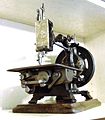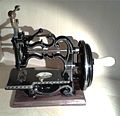User:Panjigally/sandbox
Collecting Antique and Vintage Sewing Machines.[edit]
An antique sewing machine can be regarded as one that is rare, in good condition and manufactured at least 100 years ago. However, there are many machines that are older than this but so common that they are not properly regarded as antiques. A vintage machine may be younger than this, perhaps produced as late as the 1960's. These are still sometimes valued and collected due to their rarity and unique design. Any example manufactured before 1890 and in good condition is likely to be a rare and collectible antique. There are a few very old machines that did not work reliably, even when first produced, but are still desired by collectors. A Vintage machine may be only 30 years old but will still be in excellent condition, of a high quality, the best of its kind or an unusual decorative design. Unlike antique machine collectors many vintage enthusiasts still use their machines.
Mid to Late Victorian Machines[edit]
A sewing machine has to be rigid and reproducible. It was an easy step to adapt ironwork factories for the mass production of sewing machines. Therefore, despite their great weight, most early models were of cast iron, drilled to accept steel fittings for the moving parts.
With a few exceptions there were two main systems: a twisted chain stitch using the James Edward Allen Gibbs rotating hook and a lock stitch using a boat shaped shuttle or Allen B. Wilson's rotating hook. In addition there was always some way of moving the needle vertically through the fabric and a method of advancing the material after each stitch. With minor variations in the chosen mechanics and manufacturers would apply their own ornamentation to the shape of the casings and add varying degrees of surface decoration. Sometimes this was all that separated one machine from another. Between 1865 and the end of the century sewing machines became an eye catching, practical additions to the home displaying all the flamboyance of the late Victorians.
-
Avon Sewing Machine (UK).
-
A rare White Gem (USA).
-
A Raymond-Weir (Canada).
-
A Johnson Clarke Home Shuttle (USA).
The turn of the century[edit]
The patent thicket which led to the Sewing Machine Combination (1856 to 1877) allowed manufacturers to use the best ideas for each task the sewing machine had to perform. By the turn of the century improved iron casting techniques led to a common design utilising the most efficient and reliable patents so that many machines displayed the overall look that we associate with the modern device. They were very robust and millions have survived so that, despite their age, they carry little aesthetic or monetary value unless they are in mint condition or have some unusual characteristics appreciated by enthusiasts.
-
A German Gritzner Number 1 sewing machine from about 1930.
-
A German design Frister & Rossmann sewing machine from about 1920.
-
Stoewer Sewing Machine from about 1910.
-
Collier No3 Sewing Machine imported to the UK and re-badged - from about 1930
Some later models...
-
A Singer 66 with the Lotus design.
-
Singer 99 in very good condition.
-
A Singer 222k Featherweight, a vintage alloy machine from 1954.
Collecting[edit]
Most collectors prefer the very early machines for display but there are a growing number who still use vintage models from the first half of the 20th century. The singer 66, 99 and Featherwieght are amongst these.
Collections[edit]
http://www.sewalot.com/sewing_machine_collection.htm
The Warren Collection at http://teahippo.uk/antiquesewingmachines/
The sewmuse virtual collection http://www.sewmuse.co.uk/
The Hopkirk Museum https://www.hobkirk.co.uk/hobkirks-sewing-machine-museum
The London Sewing Machine Collection http://www.craftysewer.com/acatalog/wimsew_catalog_Views_of_the_Museum_341.html
References[edit]
External links[edit]
Antique Sewing Machines[edit]
Categories:[edit]
Domestic or Industrial[edit]
Most collectors choose domestic machines, which were generally smaller than industrial models and were produced in hundreds of thousand during the late 19th and early 20th centuries by dozens of manufacturers, in several countries.
Manufacturer[edit]
Some companies produced unique machines such as the Wilcox and Gibbs, Ideal or Moldacot. Others would manufacture an entire machine, identical to that of another enterprise but with a different name whilst others merely imported machines and re-badged them with their own brand. Collectors identify examples as much by the shape of the casting or the particular patents employed as by the name printed on the casing. There were scores of manufacturers throughout the USA, Europe, Britain and Canada. There are many collections specialising in just one producer or producers from just one country.
Mechanism[edit]
There are only two common ways of forming a stitch, the lockstitch or the chainstitch. The shuttles for a lockstitch machine are either reciprocating boat shaped or they are disc shaped in a rotating frame. There are few successful variations from this basic system so collectors will look for examples employing various ingenious methods of moving the shuttle. As manufacturing technology improved levers and cams made from castings were replaced by cogs and finely machined parts. The earliest chainstitch machines used a simple hook or looper to form a stitch which would come undone. Apart from some toys this method was largely abandoned when the Gibbs rotating hook, which formed a twisted secure chain-stitch, was invented. Simple rotating hooks could be made from flat plate and were often used in toy machines. They were not very successful at sewing so collectors still find very old examples these, unused in very good condition. The device to move the fabric after each stroke is nearly always Wheelers Four Motion feed or a walking foot (vertical feed).
Shape and decoration[edit]
Many cast iron machines had identical mechanics, even down to their dimensions and differed only in the shape and decoration of the casting and decals. Early decals were hand painted, usually in gold but these were soon replaced with transfers which became more and more ornate and complex. Some re-badged machines were distinguished only by their decals. This superficial decoration was easy worn away so the value of even common examples increases considerable if the decals are in prime condition.
Condition[edit]
It is widely accepted that the condition of an antique machine be judged against a criteria first outlined by Graham Forsdyke.http://ismacs.net/condition.html This gives a number from 1 to 10, with a 10 denoting a machine in mint factory condition and a 1 denoting an example for spare parts only.
Toys[edit]
Some collections are limited to toys only. Most of these are simple loopers or use the Gibbs rotating hook. A producer of full sized machines may have sold a well engineered toy in the expectation that the recipient will buy the real thing in later life. These are the most sought after examples. (Singer 20) However there are also a number of poorly designes toys which, whilst having they had the appearance of a miniature working machine did not function well. (singer, muller, casige)
Industrial machines
Notable collections
Online collectiones sewalot, london, singer, science museum, gravesham
information sources sewalot, ismacs, gravesham,












